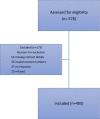Transient Anosmia and Dysgeusia in COVID-19 Disease: A Cross Sectional Study
- PMID: 37333880
- PMCID: PMC10275370
- DOI: 10.2147/IJGM.S408706
Transient Anosmia and Dysgeusia in COVID-19 Disease: A Cross Sectional Study
Abstract
Objective: This study aims to explore the prevalence of anosmia and dysgeusia and their impact on COVID-19 patients.
Methods: This is a cross-sectional study. Patients diagnosed with COVID-19 between 1st October 2020 and 30th June 2021 were randomly selected from a national COVID-19 registry. COVID-19 cases were diagnosed using molecular testing method which measured the viral E gene. The Anosmia Reporting Tool, and a brief version of the questionnaire on olfactory disorders were used to measure the outcomes via telephone interviews. Data were analysed using SPSS 27 statistics software.
Results: A total of 405 COVID-19 adults were included in this study, 220 (54.3%) were males and 185 (45.8%) were females. The mean±SD age of participants was 38.2 ± 11.3 years. Alterations in the sense of smell and taste were reported by 206 (50.9%), and 195 (48.1%) of the patients, respectively. Sex and nationality of participants were significantly associated with anosmia and dysgeusia (p < 0.001) and (p-value=0.001) respectively. Among patients who experienced anosmia and dysgeusia, alterations in eating habits (64.2%), impact on mental wellbeing (38.9%), concerns that the alterations were permanent (35.4%), and physical implications and difficulty performing activities of daily living (34%) were reported.
Conclusion: Anosmia and dysgeusia are prevalent symptoms of COVID-19 disease, especially among females. Although transient, anosmia and dysgeusia had considerable impact on patient's life. Neuropsychological implications of COVID-19 in acute infection phase and prognosis of anosmia and dysgeusia in COVID-19 are areas for further exploration.
Keywords: COVID-19; anosmia; dysgeusia; quality of life; smell; taste.
© 2023 Ali et al.
Conflict of interest statement
The authors declare that they have no competing interests in this work.
References
-
- Lechien JR, Chiesa-Estomba CM, De Siati DR, et al. Olfactory and gustatory dysfunctions as a clinical presentation of mild-to-moderate forms of the coronavirus disease (COVID-19): a multicenter European study. Eur Arch Otorhinolaryngol. 2020;277(8):2251–2261. doi:10.1007/s00405-020-05965-1 - DOI - PMC - PubMed
LinkOut - more resources
Full Text Sources


